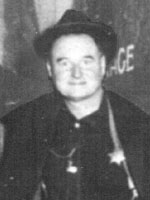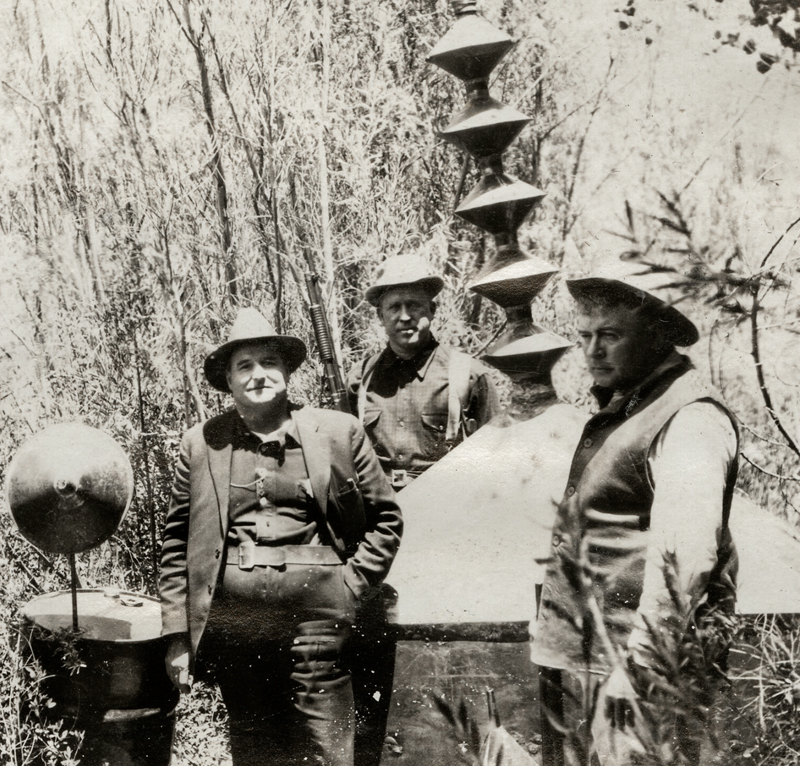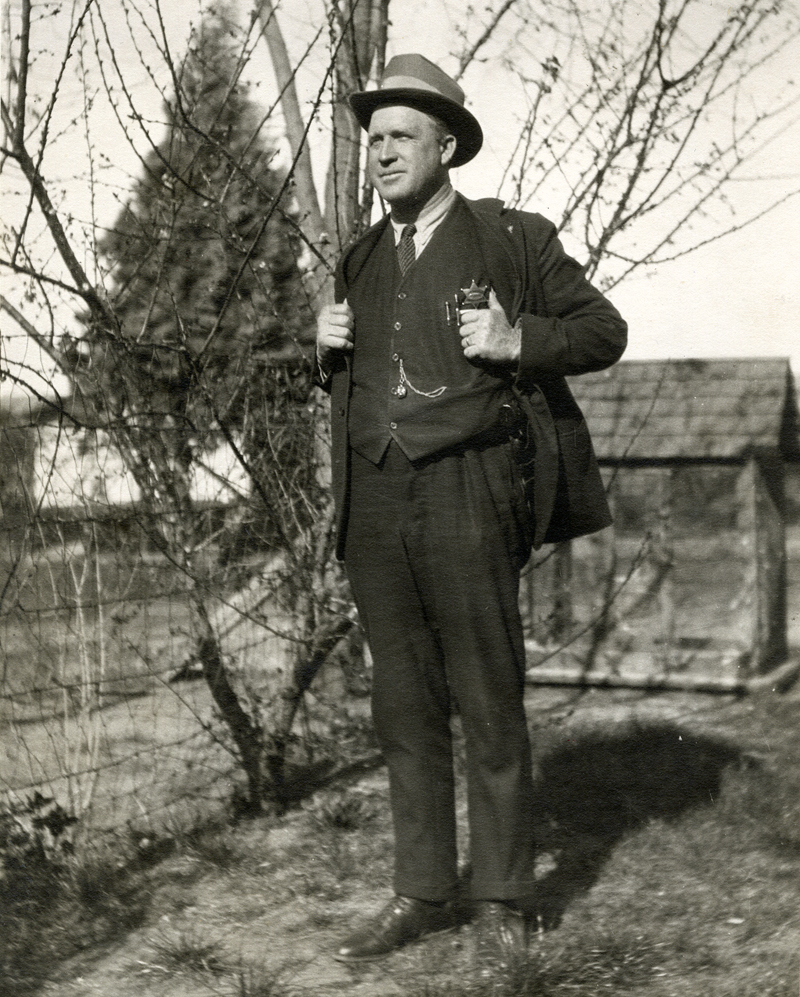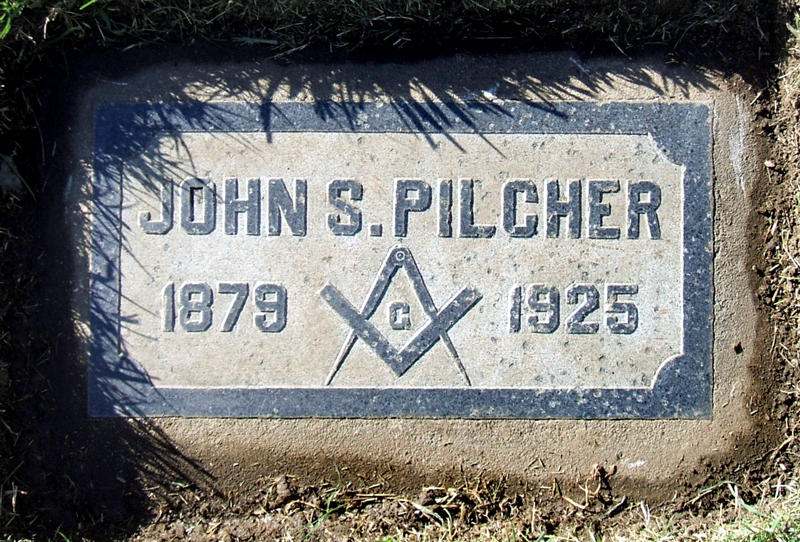In the 1920s, Prohibition was the law of the land — but that didn't stop people from drinking or making moonshine whiskey.
Even with our dirt back roads dotted with kidney-bruising potholes, we were comfortably close to the seaports in Ventura and Santa Barbara and to downtown Los Angeles. We also were a network of rugged canyons filled with caves and hiding places.
Bootleggers loved us.
Life being a series of opposites, we needed an anti-bootlegger.
Enter one Jack (born John Samuel) Pilcher, easily the most famous Los Angeles County Sheriff's Deputy ever to work the Santa Clarita substation.

Jack Pilcher
|
Pilcher earned national headlines for his daring encounters with criminals, from gin runners to bank robbers. The Los Angeles Examiner hailed him as, "the hero of a score of battles with gunmen in which he always emerged unscathed, and one of the most picturesque officers in the country." Pilcher was written up in newspapers as far away as Chicago and New York as "an officer who always got his man."
It was Pilcher who captured the Jenks Harris bank-robbing gang in a gun battle out in Castaic. It was Pilcher who caught shotgun-toting Lydia Newton for holding up a train in Canyon Country. It was Pilcher who arrested literally dozens of moonshiners in this area, including a light-hearted (and light-headed) gang at the old Saugus Train Station.
Pilcher got the call that there was a polite number of people sitting on the depot steps, drunk and giggly. Jack rushed out with two deputies and the gang scattered in all directions, save for three. It seems a freight train had stopped at the depot, carrying a large haul of sacramental wine for the various Catholic churches in Southern California. While the train was parked, some revelers crawled underneath. Using large hand-held drills, they bore through the wooden floors of the train and into the huge 55-gallon oak barrels, then caught the wine in buckets as some spilled onto the tracks.
By the way. Fines for making illegal whiskey could run as high as $300 for a first offense with six months in jail. A fine for drinking whiskey in one instance was $250 and 90 days in jail.
Let's have some fun with numbers.
To put that in perspective, you could buy a brand new house in Saugus for $600 in the mid 1920s.
Total.
So just for taking a sip of hooch, it could cost you the equivalent of half a house, or about $110,000 today.
Of course, the local judge wasn't always so hard-hearted in dispensing justice.

Members of Newhall's Dry Squad — Constable Jack Pilcher (left), Deputy Constable Ed Brown (center) and a third officer bust up a still in one of the local canyons during Prohibition in 1924.
|
Pilcher found some locals intoxicated out in the boonies. When his patrol car shined lights on the campfire party, the men stumbled around, trying to hide their moonshine. When officers found a few bottles in the shrubbery, one of the 1925 drunks explained, "It was just growing there."
The judge thought it a funny enough story to fine the locals just $7.50.
Or about one week's house rent in 1920s money.
The enthusiastic lawman Pilcher was also the subject of a delightful anecdote about life in simpler, quieter times.
The sheriffs got a call in 1924 about youths terrorizing the town with Halloween pranks, like stacking garbage on people's front lawns. It was a small town and Pilcher quickly found out who the suspected teens were. He went to their homes late that night, loaded them in the prowl car and drove them around town to the locales where they had scattered garbage. Before sun-up, all the lawns were clean and the teens were taken back to their parents' homes.
Then, on the other hand, there was the time Jack Pilcher also shot Gus LeBrun 18 times.
That was in mid-September 1924.

Deputy Constable Ed Brown, April 8, 1924.
|
LeBrun was a local handyman who had the misfortune of falling for the part-time booze chef and full-time town floozy, Nellie Bayless, aka Bonita Darling. Darling had promised to marry LeBrun after he had loaned her $400. Then the beautiful tease laughed in Gus' face when he asked when they would be wed.
LeBrun showed up one night at her doorstep, drunk, and told Darling he was going to kill her. She fainted, revived, then asked if they could talk this out over dinner. Darling gasped that there simply wasn't a crumb of food in the house and that Gus should wait there until she went into town to get some groceries.
Of course, Darling went to get Newhall Sheriff Ed Brown and his deputy, Jack Pilcher.
When the two lawmen rounded the entry boulder to her Pine Canyon Road ranch, LeBrun ran out the other side and started firing. The two men bailed from their Model T and returned fire, hitting LeBrun.
The handyman called out that he had been hit and asked them to stop firing.
Again, this was a small town. Ed and Jack knew the man. Ed walked over to tend to Gus's wounds, and when he rolled the man over, LeBrun produced a revolver and shot Ed in the chest. Pilcher followed by emptying every bit of ammo he could find into LeBrun.
Gus was dead and then some.
Brown died in his partner's arms, asking Jack to tell his wife, "I won't be home for dinner."

Constable John S. "Jack" Pilcher is buried at Grand View Memorial Park in Glendale. Photo courtesy of Ann Stansell. Click to enlarge.
|
Pilcher died within a year in the strangest accident.
Pilcher and his rookie partner, John Seltzer, were investigating a break-in at the Gage Ranch up Bouquet Canyon. They found the cabin wide open but couldn't find any prowlers. The men spotted a large lizard scampering into the house and went in after it. The creature sprinted under a bed. The men went to opposite sides to scare the thing out.
The rookie was carrying his pistol in his shirt pocket. When the pair bent over at the same time to look under the bed, the pistol fell out of Seltzer's pocket, hit the ground, discharged, and a round went right between Jack Pilcher's eyes.
Pilcher was given a hero's funeral through downtown Newhall on June 18, 1925. It was paid for by the local chapter of the Ku Klux Klan. [This needs to be sourced — Ed.]
A fellow by the name of Jack Sanderson was deputy out here for a short spell. He made such poor wages, local businessmen passed the hat for him.
Jim Biddison lasted a bit longer. A rancher who homesteaded here in 1902, Biddison took over for Brown and Pilcher in 1925 and worked here 20 years. The cowboy had been a deputy in Denver when a newly elected Populist Party sheriff was elected. This Denver sheriff's first act was to fire every non-Populist deputy on the force — including Big Jim.
Sheriff's Deputy Biddison can best be remembered as the man who tracked down Buffalo Tom Vernon, the infamous train robber who derailed the old "Owl" train on the cold November 10th night of 1929, behind where Saugus Speedway sits today.
To pay for a lady friend's "operation," the smallish Vernon loosened some tracks and waited for the Southern Pacific locomotive and passenger train to derail. It did. Vernon climbed aboard and held up the stunned passengers for a total of $300.
Not to take anything away from our rancher-sheriff, but it didn't take much detective work to find out Buffalo Tom was the culprit. Next morning, Biddison backtracked the footprints leading to a tool shed near which Vernon had been squatting. As a bonus, Buffalo Tom had been kind enough to leave a hand-written letter bearing his name, address and travel plans.
Biddison brought the former Buffalo Bill Wild West Show sharpshooter and trick rider back from Wyoming (where he had derailed and robbed a second train) to justice. Vernon was given life in Folsom but was released in 1967, an aged man. Biddison retired much earlier, in January 1945.
While today's law enforcement officials might complain of being stretched too thin on their beats, they may want to have talked to Biddison. His territory covered north to Fort Tejon on the other side of the Tehachapis, up to the Palmdale city limits and over the hills south and west to the San Fernando Valley — about 1,000 square miles.
Fortunately for local officers, mucky-mucks at Sheriff's headquarters began to see the numbers. A Newhall-based deputy covering a crime in Frazier Park would have to take at the very least three hours to two full days.
That's stretched thin.
©2000 JOHN BOSTON & SCV HISTORICAL SOCIETY | RIGHTS RESERVED.
